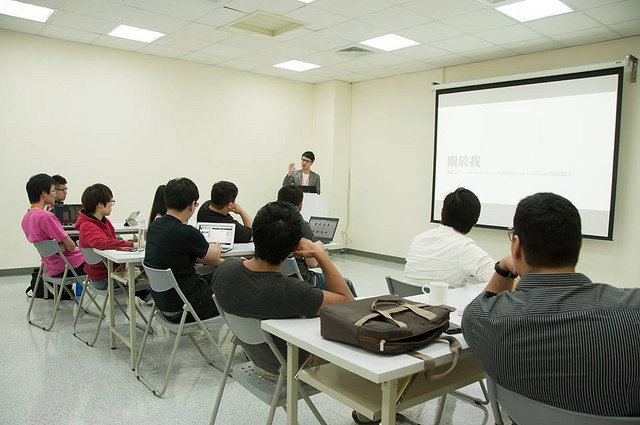
新竹首間共同工作空間「Yes Co-working Space」,在交大加速器中心的營運下,不只是個空間,更是個創業家學校,透過精心設計的創業課程「YESer Startup Program」,從社會責任、商業、行銷、財務到法務等訓練,幫助有志青年加速實現創業夢想。這次請到 Startup Weekend Taiwan 第九屆共同發起人 Will 陳胤嘉,來分享「創業家要知道的服務設計」,探討行為背後的邏輯。接下來將透過三大重點「Definition、Mindset、Method」來分享我的心得筆記。
Definition
使用者經驗、服務設計等是最近很火紅的字眼,但是到底什麼是 Service Design?Service Design Thinking?Design Thinking?User Experience?以前 Goods 和 Service 是兩者不同的東西,現在則結合在一起,稱為 Service Design。其實清楚地了解定義是非常重要的事情,唯有明確的定義,我們才能透過這些從國外紅回台灣的方法來改善我們的服務。
關於 Service Design:
"Service design is the activity of planning and organizing people, infrastructure, communication and material components of a service in order to improve its quality and the interactionbetween service provider and customers. The purpose of service design methodologies is to design according to the needs of customers or participants, so that the service is user-friendly, competitive and relevant to the customers."
關於 Service Design Thinking:
1.Think in service: from Goods domain logic to Service domain logic.
2.Service design is not new.
3.Service design is inter-disciplinary.
4.Every discipline has its language, ex: Marketing, IT, Design, Sales etc., Service design thinking is a common language.
5.Service design thinking is an iterative process.
關於 Design Thinking:
“Design thinking is a human-centered approachto innovation that draws from the designer's toolkit to integrate the needs of people, the possibilitiesof technology, and the requirementsfor business success.”
—Tim Brown, president and CEO
關於 User Experience:
使用者經驗(User Experience)泛指的是使用者在接觸並且使用過產品或者服務以後,對於產品和產品的提供者所形塑的一種經驗認知。使用者經驗設計在於如何透過以「人」為中心(User-centered)的開發流程,利用系統化、科學化的方式去研究、了解目標使用者的行為模式和限制,並且將這些要素考慮在設計的流程當中,同時透過適當的方法來評量設計的結果,驗證是否符合預期的使用者經驗,這中間也包含了產品或者服務所應該符合的使用性(Usability)。
Mindset
定義很複雜,但其實簡單來說,就是四循環:「觀察、定義、創造、驗證」,任何一個想法都是在重複做這四件事情,但是中間都得放入 User 的概念。重點是「User Centered」,以及「行為背後的邏輯」。UI (User interface) 是使用者接觸到的界面,UX (User Experience) 則是不同階段不同範疇的組合,比 UI 來得複雜很多。
“人們常把「UI」跟「UX」兩個詞混著用。UX這詞其實很奇妙,因為它本身並沒有指涉任何一件特定的事。介面設計、視覺風格、程式效能、正常運作和功能都是「UX」的一環。而UX相關書籍更是包含了研究和開發方法的理論,把事情變得更複雜。”
─RyanSinger, UI Designer from 37Signals
"There will always, one can assume, be need for some selling. But the aim of marketing is to make selling superfluous. The aim of marketing is to know and understand the customerso well that the product or service fits him and sells itself. Ideally, marketing should result in a customerwho is ready to buy. All that should be needed then is to make the product or service available.”
─ Peter Drucker
Will 和我們分享了 TED Talk 影片 Simon Sinek 的「偉大的領導者如何鼓動行為」,從中 Simon 分享到 Golden Circle 的理論,凡事都從「why」開始,因為 why 才是說服人的重點。若要達到 mass-market success 或者是讓 mass-market 接受一個全新的想法,需要吸引 innovators 及 early adopters,而要讓這些人勇敢嘗試新的事物,其驅動力來自於 what they believe about the world。
“People don’t buy what you do, they buy why you do it.” - Simon Sinek
我們複製了一堆先進國家的管理做法,製作了一堆文件表格,希望提升品質和效率;但絕大多數的結果只是,我們複製了一堆做法(文件表格),卻沒有複製到精神(管理原則);我們只看到了 what they do,但我們不懂 why they do。重要的是 why 而非 what,Mindset 遠比 Method 來得重要,Mindset 是精髓所在。
Method
講完了 Mindset 接著談到如何善用 Method,Will 強調千萬不要忘記 Method 裡頭蘊含的 Mindset。UX 分為兩個層次,一是設計之前要先瞭解怎麼規劃,二是規劃之前先洞察使用者,而在這之前首先要找到使用者(User)以及關係人(Stakeholder)。
觀察:
1. 著重行為而非意見,因為使用者會無限擴張他想要的東西,而且問題會影響到他們的回答。
2. 追根究底,質性研究常用的方法。
(以上兩者要看情況使用,有產品則追根究底,有構想則觀察行為。)
3. 掌握情境
4. 問問題:人事時地物
記錄:
用相機、錄音筆留取純粹的資訊,最後再用手、只筆記錄下來
模擬:
10 : 10,000,質化研究與量化研究需要取捨,練習在相同情境下,做優缺點分析,在從中挑選最適合的
Case:找到使用者,觀察 、再觀察 ,描述、再描述
1. Questionnaire:量化質化問卷
2. Focus group:焦點團體
3. Culture Probe:提供基本的工具,讓目標使用者記錄他的行為,結束後會得到一堆資料,再從中分析)
4. Persona:收斂並將消費者歸類,定義消費者行為、對使用者做標籤,例如:小資女、宅男
5. Customer jouurney:著力于接觸點,這些接觸點是切入消費者心理的重點。例如:消費者會使用籃子,放入購買的物品。則接觸點為籃子
未來同理心是重點:
The Empathy map: Think & Feel, See, Hear, Say & Do
Pain + Gain = 解決問題(痛點) + 創造價值(獲得)
最後,Will 分享了那些創業家教我的事:
1. Validation:走出去,接觸人群
2. Stakeholder:B2B別忘了C才是買者
3. 競爭的兩把刀:Technology or Content
4. 關於競爭:要想的是未來的產品
5. 佈局:思考的是未來的競爭,永遠要想未來事業要如何往前走